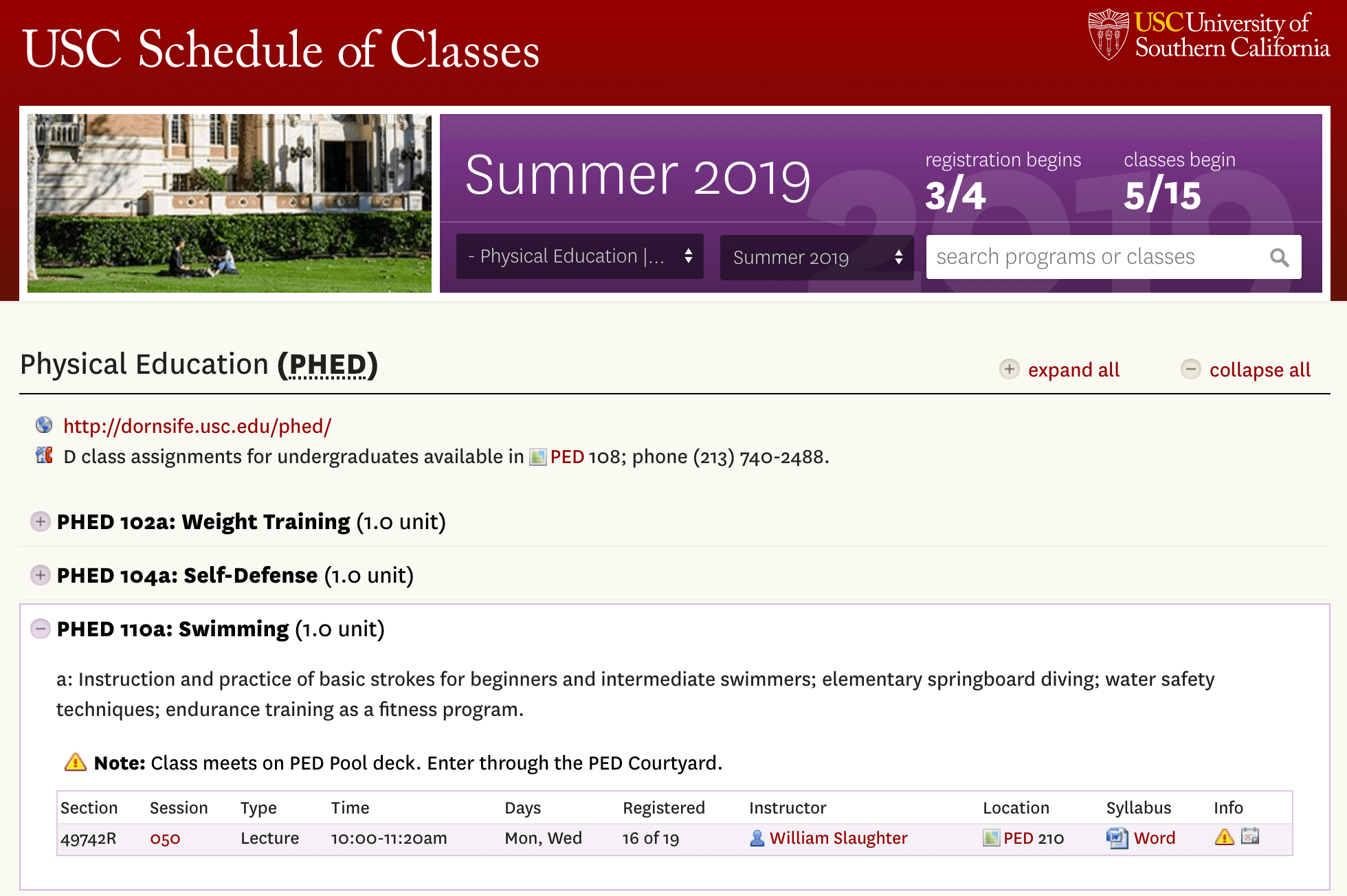Hello there once again. In my previous post, I gave an introduction to the swimming facilities at USC. This post will talk more about the actual act of swimming. If you want to learn swimming at USC, the course PHED 110A is an excellent option. It is offered in every semester, including summer.
As you might know, there are 4 primary strokes in swimming – front crawl (or freestyle), back crawl (or backstroke), breaststroke and butterfly. For many people, freestyle is the easiest to learn and the best option for both speed and distance. If you’re visualizing a person swimming, you’re probably visualizing them swimming freestyle. A lot of people just hit the pool to swim laps of freestyle. Freestyle requires you to kick your legs and move your arms alternately. In PHED 110A, you’ll start by learning how to kick, then move on to the arm movements. If you have no knowledge of swimming, it should take about half a semester to feel comfortable swimming freestyle. However, take all the time you need. Freestyle is the mainstay in a casual swimmer’s routine, and you should feel confident about it.

If looking for a complete workout, you should try to swim all the 4 strokes. Backstroke is just freestyle on your back. This creates a sense of serenity as you’ll be looking straight up towards the sky (or the roof if you’re in the indoor pool) and won’t have to be worry about breathing. Some people don’t like backstroke because you can’t see where you’re going. However, it is a nice and relaxing stroke. If you want to completely let go, you can just float on your back and experience the bliss! The course PHED 110A starts teaching backstroke about a third of the way through the semester.
After the halfway point in the semester is when you’ll start getting to breaststroke. I used to hate breaststroke for a long time because it felt too tiring to traverse a given distance. That’s when I realized I was not doing it right. The key in this stroke is to glide, where you shoot your hands in front of you and snap your legs together to propel your streamlined body through the water.

Pic courtesy Pinterest
Finally, you will get to the bane of many a swimmer – the butterfly. Described variously as tiring, elegant, beautiful and pointless, the butterfly is like trying to swim freestyle with both arms and legs at the same time. This gives you a burst of speed when you push the water back with both arms together, but try doing it over long distances and you will start to cut a sorry figure. Don’t worry if you cannot master the butterfly, but if you can, it is great for impressing people!
There are also other strokes not counted in the primary 4, such as elementary backstroke. This is sort of like a version of breaststroke on your back, in that you snap your feet and glide across the water. Sidestroke, which is covered in PHED 110A, is a stroke good for swimming long distances if you can do it right, and is often used in rescue operations. And finally, the individual medley combines butterfly, backstroke, breaststroke and freestyle in that order in a grueling workout which will leave you panting (but happy)!
If you don’t want to cover horizontal distance, you can opt for other water exercises such as dives and treading water. Dives can be performed from the side of the pool into the deep end, or you can perform a surface dive by going under from above the surface of the water. One of my favorite exercises is touching the bottom of the pool and coming back up. But know your capacity before you do this, particularly since the dive pool at USC’s Aquatics center has a maximum depth of 17 feet! Treading water is trying to stay vertical in deep water with your head above the surface.
Swimming is a joyous activity. It refreshes you, makes you feel cool when it’s hot outside and warm when it’s cold outside, and keeps you in shape. Different strokes work different areas of your body and improve your stamina. I’ve felt happier and less stressed since I started swimming, and look forward to doing it almost every day. Thanks to USC, there is no shortage of facilities for swimming. Whether you are a casual swimmer looking to stay fit or a competitive person taking part in meets, here’s hoping that you enjoy yourself in the pool.
Published on June 19th, 2019Last updated on April 1st, 2021
